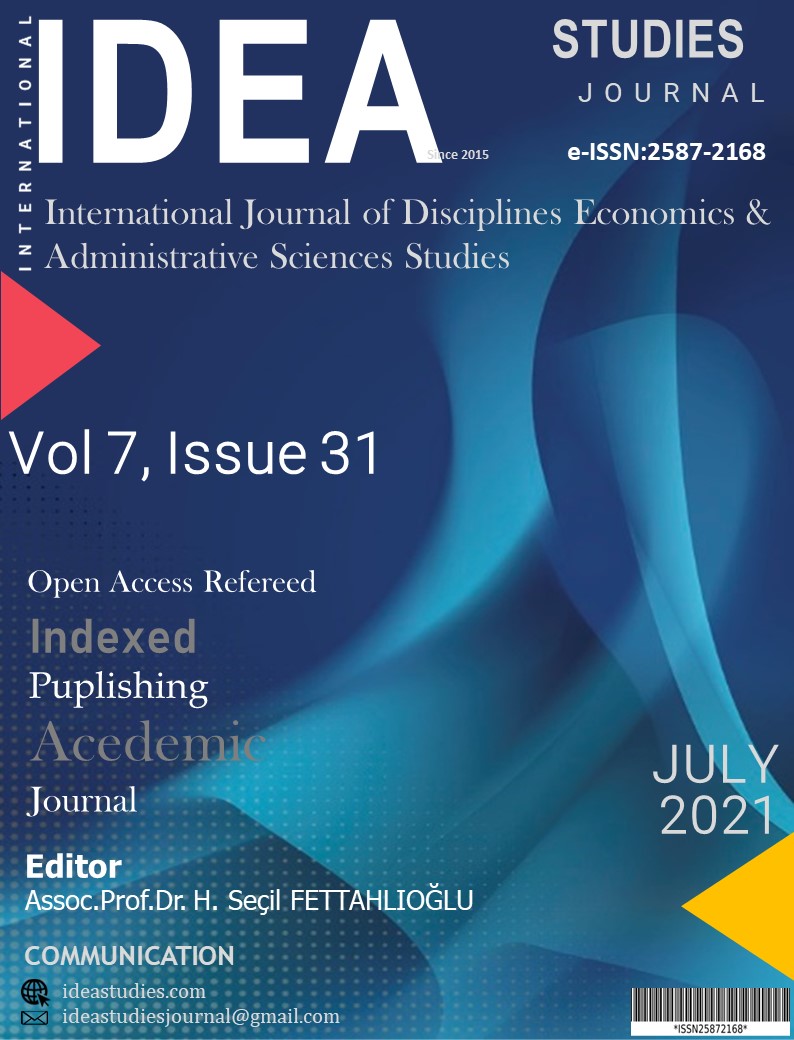Author :
Abstract
Kadın ile ilgili istatistikler, toplumsal cinsiyet eşitliğinin sağlanması, kadının toplum içindeki yerinin belirlenmesi ve sosyo-ekonomik kalkınma içinde, kadınların katkısının güçlendirilmesi ve olumsuz göstergelerin tespit edilerek sosyal ve ekonomik konumlarının iyileştirmesi için oldukça önemlidir. Bu çalışmada veri madenciliği sınıflama (denetleyici öğrenme) modellerinden k-ortalamalar algoritması ve CHAID karar ağacı algoritmaları kullanılarak, 81 ilin 2019 yılına ait nüfus, doğurganlık, sağlık, evlenme, aile yaşamı, eğitim, siyasal yaşam, iş hayatı konuları kapsamında, toplumsal cinsiyet bakış açısıyla seçilen toplumsal yapı ve toplumsal cinsiyet göstergelerine göre sınıflandırılması ve bu sınıflandırmada etkili olan kuralların ve değişkenlerin belirlenmesi amaçlanmaktadır. Cinsiyet eşitliğini sağlamaya yönelik önlemlerin ve iyileştirmelerin bölgesel düzeyde farklılıklarla ele alınması önemlidir. Bu çalışma sonuçlarının aynı zamanda bölgesel düzeyde cinsiyete dayalı eşitsizliğe ilişkin göstergelerin ölçülmesi, takip edilmesi, karşılaştırılması ve toplumsal cinsiyet eşitliğine yönelik bölgesel düzeyde farkındalık oluşmasına katkı sunması amaçlanmaktadır.
Keywords
Abstract
Statistics on women are very important for achieving gender equality, determining the place of women in society and strengthening the contribution of women in socio-economic development and improving their social and economic status by identifying negative indicators. In this study, using the k-means algorithm and CHAID decision tree algorithms, one of the data mining classification (supervisory learning) models, the gender perspective in 81 provinces within the scope of 2019 population, fertility, health, marriage, family life, education, political life, business life. It is aimed to classify them according to the selected social structure and gender indicators and to determine the rules and variables that are effective in this classification. It is important that measures and improvements aimed at achieving gender equality are addressed with regional differences. The results of this study are also aimed to measure, monitor and compare indicators of gender-based inequality at the regional level and contribute to raising awareness on gender equality at the regional level.
Keywords
- Berktay, F. (2011). Feminist teoride açılımlar, toplumsal cinsiyet çalışmaları. Eskişehir: Anadolu
- Berktay, F. (2011). Feminist teoride açılımlar, toplumsal cinsiyet çalışmaları. Eskişehir: Anadolu Üniversitesi Yayını, 2-23.
- Chandola,V., Banerjee, A., Kumar,V., (2009). Anomaly Detection : A Survey, ACM Computing Surveys, University of Minnesota,1,72.
- Ekici, E. (2012). Farklı sınıflandırma yöntemlerinin karşılaştırılması ve bir uygulama, Yüksek Lisans Tezi, Fırat Üniversitesi Fen Bilimleri Enstitüsü, Elazığ, 13-19.
- Gökçin, G.Merve, (2019). Çimento ve Taş Kömürü örnek sektörlerinde stok miktarı tahmini için sınıflamatipi modeller ile çoklu regresyon modellerinin karşılaştırılması, Doktora Tezi, Gazi Ünv. Sosyal Bilimler Enstitüsü, Ankara, 84-86.
- OECD, (2019). Social Institutions and Gender Index 2019 [Veri Seti]. Erişim adresi: https://stats.oecd.org/Index.aspx?DataSetCode=SIGI2019
- Oktay, G.Merve, (2013). Aylık sanayi üretim verisinin veri madenciliği ile incelenmesi ve model performanslarının değerlendirilmesi, Türkiye İstatistik Kurumu, Uzmanlık Tezi, Ankara, 58-59.
- Pehlivan, G. (2006). CHAID analizi ve bir uygulama, Yüksek Lisans Tezi, Yıldız Teknik Üniversitesi Fen Bilimleri Enstitüsü, İstanbul, 17.
- Sarp, Ü. (2008). Toplumsal cinsiyet eşitliği, T.C. Başbakanlık Kadının Statüsü Genel Müdürlüğü, Ankara, 6- 8.
- SGK, (2019). İşyeri, Sigortalı, Aylık ve Gelir Alanlara Ait İstatistikler [Veri seti]. Erişim adresi: http://www.sgk.gov.tr/wps/portal/sgk/tr/kurumsal/istatistik
- TÜİK, (2019). Toplumsal yapı ve cinsiyet istatistikleri [Veri seti]. Erişim adresi: https://data.tuik.gov.tr/Kategori/GetKategori?p=nufus-ve-demografi-109&dil=1
- TBMM,(2019). Türkiye Büyük Millet Meclisi Milletvekilleri Dağılımı [Veri seti]. Erişim adresi: https://www.tbmm.gov.tr/develop/owa/milletvekillerimiz_sd.dagilim
- WEF, (2019). 2019 Küresel Toplumsal Cinsiyet Uçurumu Raporu. Erişim adresi: https://www.weforum.org/reports/gender-gap-2020-report-100-years-pay-equality





